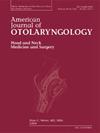Enhanced recovery in unilateral vestibular hypofunction: The synergistic effect of medication and vestibular rehabilitation training
IF 1.7
4区 医学
Q2 OTORHINOLARYNGOLOGY
引用次数: 0
Abstract
Objective
This study aimed to compare the efficacy of medication combined with personalized vestibular rehabilitation training (VRT) versus medication alone in unilateral vestibular hypofunction (UVH) and identify predictors of long-term symptom progression.
Methods
Forty-eight UVH patients were randomized into a VRT group (n = 23, medication combined with personalized VRT) and a control group (n = 25, medication alone). Bithermal caloric tests, Dizziness Handicap Inventory (DHI), Vestibular Rehabilitation Benefit Questionnaire (VRBQ), Visual Analog Scale (VAS), Activities-specific Balance Confidence Scale (ABC), and Self-Rating Anxiety Scale (SAS) were assessed at baseline, 2 weeks, and 4 weeks. Symptom progression was tracked over 6 months post-intervention.
Results
Both groups improved significantly (P < 0.05), but the VRT group showed faster unilateral weakness (UW) reduction (30.43 % vs. 43.20 % at 4 weeks, P = 0.012) and greater symptom relief (DHI: 6.70 vs. 23.68, P < 0.001). Logistic regression identified abnormal UW (≥ 25 %) as an independent predictor of symptom recurrence (OR = 7.237, 95 % CI:1.43–36.58, P = 0.017), while DHI scores showed no significant association (P = 0.925).
Conclusion
Personalized VRT combined with medication accelerates symptom resolution and vestibular recovery compared to medication alone. Persistent abnormal caloric results, even with symptom relief, indicate a need for extended treatment and active lifestyle maintenance to mitigate recurrence.
增强单侧前庭功能障碍的恢复:药物和前庭康复训练的协同作用
目的本研究旨在比较药物联合个性化前庭康复训练(VRT)与单独药物治疗单侧前庭功能减退(UVH)的疗效,并确定长期症状进展的预测因素。方法48例UVH患者随机分为VRT组(n = 23,药物联合个性化VRT)和对照组(n = 25,单独用药)。在基线、2周和4周分别对双热热测试、头晕障碍量表(DHI)、前庭康复益处问卷(VRBQ)、视觉模拟量表(VAS)、特定活动平衡信心量表(ABC)和自评焦虑量表(SAS)进行评估。干预后6个月追踪症状进展。结果两组均有显著改善(P <;0.05),但VRT组单侧虚弱(UW)减少更快(30.43% vs. 43.20%, P = 0.012),症状缓解更大(DHI: 6.70 vs. 23.68, P <;0.001)。Logistic回归发现异常UW(≥25%)是症状复发的独立预测因子(OR = 7.237, 95% CI:1.43 ~ 36.58, P = 0.017),而DHI评分无显著相关性(P = 0.925)。结论与单独用药相比,个体化VRT联合用药可促进症状缓解和前庭功能恢复。持续的异常热量结果,即使症状缓解,表明需要延长治疗和积极的生活方式维持,以减轻复发。
本文章由计算机程序翻译,如有差异,请以英文原文为准。
求助全文
约1分钟内获得全文
求助全文
来源期刊

American Journal of Otolaryngology
医学-耳鼻喉科学
CiteScore
4.40
自引率
4.00%
发文量
378
审稿时长
41 days
期刊介绍:
Be fully informed about developments in otology, neurotology, audiology, rhinology, allergy, laryngology, speech science, bronchoesophagology, facial plastic surgery, and head and neck surgery. Featured sections include original contributions, grand rounds, current reviews, case reports and socioeconomics.
 求助内容:
求助内容: 应助结果提醒方式:
应助结果提醒方式:


